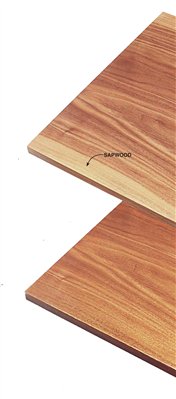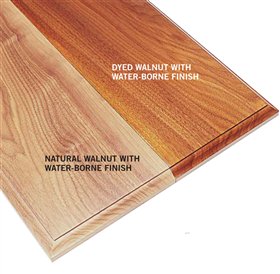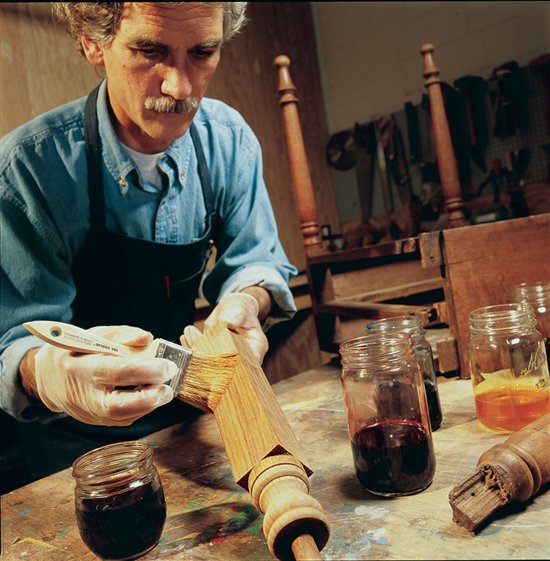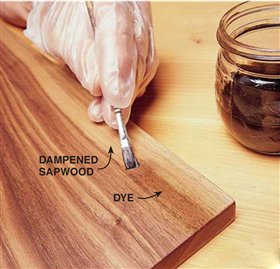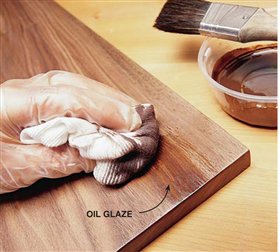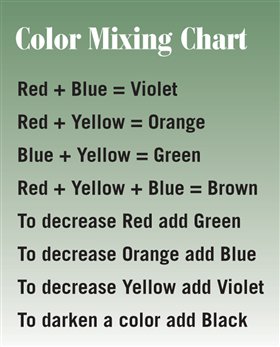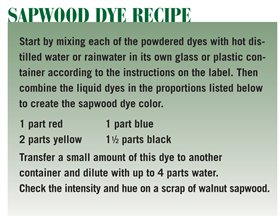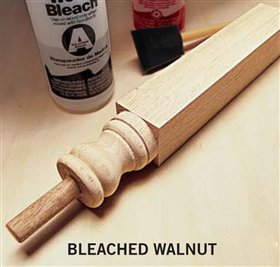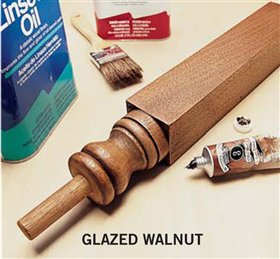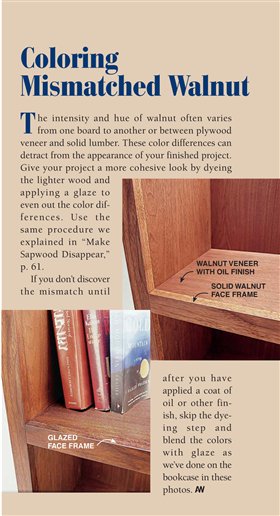Make Sapwood Disappear
Even select walnut boards are likely to contain an
occasional streak of light-colored sapwood. Some projects
benefit from the contrast provided by skillfully
placed sapwood, but in most cases it’s merely a distraction.
If you can’t afford the luxury of avoiding all sapwood, we’ll show
you how to make it less conspicuous. Even though the initial investment
for dye, shellac and glaze materials will set you back about $100, most of these
products are highly concentrated and should last you many years.
Dyeing sapwood looks paint-by-number simple but there are a few tricks. The key
to the process is getting the dye color to match the heartwood color. Don’t
bother with dyes labeled “walnut.” Buy red, blue, yellow and black water-soluble
dye powder and custom mix a sapwood. We gradually adjusted the color of the dye by adding drops of
blue and black to reach the purplish gray hue of kiln-dried walnut.
An eye-dropper works great for this. Air-dried walnut has more
red. Adjust your dye accordingly using the Color Mixing Chart provided here as a guide.
We’re using water-soluble dye because it resists fading
in sunlight better than alcohol-soluble dye and is
easy to apply without leaving lap marks. One drawback,
however, is its tendency to raise wood grain. Minimize
grain raising by wetting the wood, letting it dry, and sanding
off the raised grain with 220-grit sandpaper before applying the dye.
Don’t sand too much or you’ll expose new
wood and negate the effect.
Here are a few more tips for working with watersoluble
dye:
– Wet the end grain before dyeing it to keep it from soaking up too
much dye.
– Start with a diluted dye; you can always increase the intensity of the
color by adding a “layer” of more concentrated dye.
– Adjust the color by adding another layer (refer to the Color Mixing
Chart). Wipe on green dye to decrease red, for example.
– The color you see when you apply the dye to the wood is close to
the color you’ll end up with. The wood will look dull when the dye dries,
but the “wet” color will return when the finish is applied.
– Lighten dyed wood by wiping off some dye with a damp rag. If you
really goof, use household chlorine bleach to remove almost all of the dye.
Allow the dyed wood to dry completely, usually overnight. Then seal
the entire surface with a thin coat of brushed on shellac (about a 2-lb.
cut of super-blonde or other dewaxed shellac). Allow the sealer to dry
and sand it lightly with 320-grit sandpaper. If you’re happy with the way
the sapwood blends after the sealer is applied you can move on to applying
the final coats of finish. To blend the dyed sapwood more completely, and add greater depth and richer color, apply a thin layer
of glaze before applying the final coats of finish.
Glaze is essentially thinned paint that’s layered over a
sealed surface. Commercially prepared glazes are available,
or you can make your own. Mix up an oil glaze by
combining artist’s oil paint (available at art supply stores)
with a glazing medium consisting of three parts boiled linseed
oil, two parts mineral spirits and 1 part Japan drier, to
the consistency of heavy cream. We chose the “burnt
umber” color and it looked great. Pick up the following colors
as a starter set for blending your own custom colors;
burnt umber, raw umber, burnt sienna, raw sienna, Vandyke
brown, yellow ochre, black and blue.
Complete the process of blending the sapwood by applying
a layer of glaze, as shown in Photo 2. Keep the brush
“dry” by removing
excess glaze from the
bristles with a rag. To
add glaze in one section,
“stipple” it on
with the tips of the
bristles and then
smooth it. If you
make a mistake,
remove the glaze
using a rag dampened
with mineral
spirits.
Allow the glaze to
dry completely, a minimum of 24 hours, before applying the
final coats of finish. Check by running your hand across the
surface. If glaze rubs off, it’s not dry. |
|
Click on any image to view a larger version.

1. Use a small artist’s paint brush to carefully
dye the sapwood, following along the grain line.
Blend the edge of the dye into the heartwood with
the corner of a damp rag. Dampen the wood before
applying the dye.

2. Apply the glaze with a rag or brush. Remove the excess,
leaving a thin layer.Then use a good-quality paint brush with
soft bristles to manipulate the glaze, adding or subtracting as
needed to blend the dyed sapwood into the heartwood.



|
